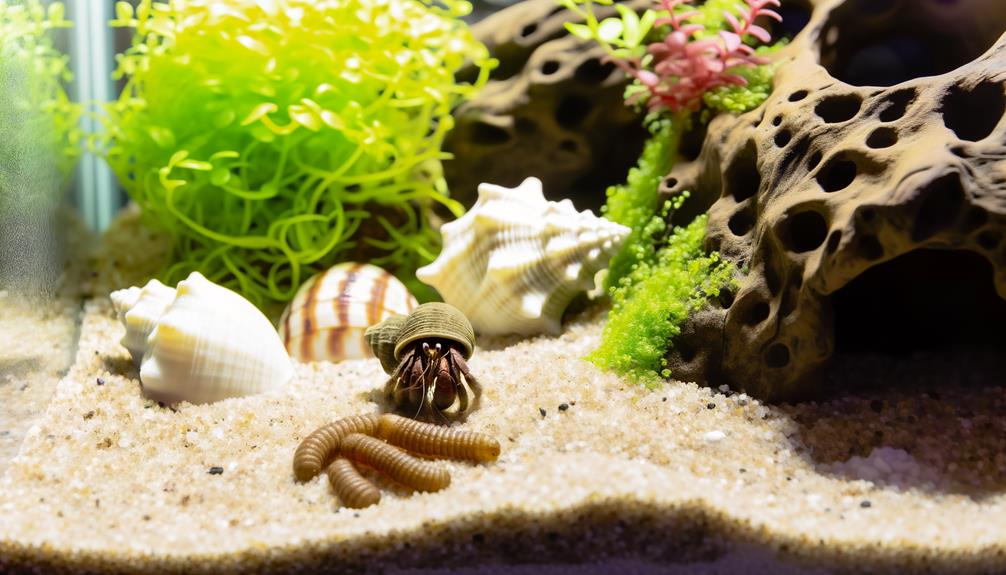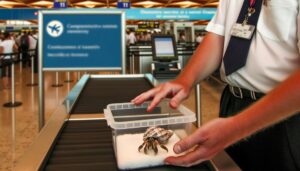Hermit Crabs Eat Mushrooms: Feeding Guide
Yes, hermit crabs can eat mealworms. Mealworms provide high levels of protein (around 20%) and fat (approximately 13%), which are vital for their growth and exoskeleton formation.
They're also rich in necessary vitamins and minerals like potassium, copper, sodium, and iron. However, you should feed them mealworms in moderation, around 2-3 times a week, to prevent obesity and other health issues due to the high-fat content.
It's vital to source clean mealworms to avoid introducing parasites. Proper storage and preparation are key to maintaining quality and health benefits.
Learn how to optimize your crab's diet with strategic feeding guidelines.

Key Takeaways
- Hermit crabs can eat mealworms as part of a balanced diet.
- Mealworms are high in protein, supporting muscle development and cellular repair for hermit crabs.
- Feeding mealworms 2-3 times a week prevents overfeeding and maintains dietary balance.
- Ensure mealworms are sourced from reputable suppliers to avoid contaminants and parasites.
- Monitor the high fat content to prevent obesity and related health issues in hermit crabs.
Nutritional Value of Mealworms
Mealworms provide a high-protein, nutrient-dense food source that can contribute greatly to the dietary needs of hermit crabs. They contain approximately 20% protein and 13% fat, essential for growth and energy.
Additionally, mealworms are rich in vitamins and minerals such as potassium, copper, sodium, and iron, which are essential for maintaining hermit crabs' overall health.
When considering their diet, you should note that mealworms also offer chitin, a component that aids in the molting process. Chitin strengthens the exoskeleton, facilitating proper development.
Benefits for Hermit Crabs
Incorporating mealworms into a hermit crab's diet provides numerous benefits, including improved growth, energy levels, and overall health. Mealworms are rich in protein, which is crucial for muscle development and cellular repair. Their high-fat content supplies necessary energy, promoting active behavior and vitality. Additionally, mealworms contain essential micronutrients like calcium and phosphorus, vital for exoskeleton formation and maintenance.
Feeding Frequency
To guarantee your hermit crab's nutritional needs are met, it's important to establish an ideal feeding schedule and appropriate mealworm portion size. Research indicates that feeding mealworms two to three times a week, in small amounts, can support balanced dietary intake.
Monitoring the portion size prevents overfeeding and helps maintain the crab's health.
Optimal Feeding Schedule
Determining the ideal feeding frequency for hermit crabs involves considering their natural eating habits and nutritional needs. In the wild, hermit crabs are scavengers who consume small quantities of food throughout the day. Replicating this, you should offer a varied diet daily.
Nutritional studies recommend providing fresh food in the morning and evening, ensuring crabs have constant access to a balanced diet. Mealworms, as a protein source, can be included every other day, complementing other essential nutrients.
Observing your crabs' behavior and waste production can help fine-tune the schedule. By adhering to these evidence-based guidelines, you'll support your hermit crabs' health and well-being, fostering an environment where they can thrive.
Mealworm Portion Size
Calculating the appropriate portion size of mealworms for your hermit crabs depends on their size and overall dietary requirements. For small hermit crabs, one or two mealworms per feeding session is sufficient. Larger crabs may consume up to four.
Guarantee mealworms are a supplementary protein source, comprising no more than 10-15% of their total diet. Feed mealworms once or twice per week to avoid overfeeding and potential nutritional imbalances. Observing your hermit crabs' behavior and physical condition can offer insights into adjusting portions.
Always remove uneaten mealworms after a few hours to prevent spoilage and maintain habitat cleanliness. Tailor mealworm portions to individual crab needs, ensuring balanced nutrition and peak health.
Preparation Tips
To guarantee your hermit crabs receive top nutrition from mealworms, start by selecting the appropriate mealworm type.
Store mealworms in a cool, dry place to maintain their quality and prevent spoilage.
Follow established feeding frequency guidelines to avoid overfeeding and secure a balanced diet.
Choosing Mealworm Types
When selecting mealworms for your hermit crabs, it's crucial to consider the nutritional content and make sure proper preparation to avoid any health risks. Mealworms should be chosen based on their protein and fat levels, as these factors significantly impact your hermit crabs' well-being.
Avoid feeding wild-caught mealworms due to potential pesticide exposure and parasites. Confirm the mealworms are gut-loaded, meaning they've been fed a nutritious diet before being offered to your crabs.
- Protein Content: Opt for mealworms with higher protein for growth and shell development.
- Fat Content: Balance fat levels to prevent obesity in hermit crabs.
- Source: Purchase from reputable suppliers to ensure quality.
- Gut-Loading: Provide nutrient-rich foods to mealworms before feeding them to crabs.
Proper Mealworm Storage
Properly storing mealworms safeguards they remain nutritious and safe for your hermit crabs.
First, keep mealworms in a ventilated container to guarantee proper airflow. Store them at a temperature of 45-50°F; a refrigerator's vegetable drawer is ideal. Avoid freezing temperatures as they can kill the mealworms.
Feed them a diet of bran or oats and provide moisture using small pieces of fresh vegetables like carrots or potatoes. Replace these food and moisture sources every few days to prevent mold growth.
Regularly remove any deceased mealworms to maintain a healthy environment. By following these steps, you'll secure mealworms retain their nutritional value, promoting the well-being of your hermit crabs.
Feeding Frequency Guidelines
Determining the best feeding frequency for your hermit crabs involves understanding their dietary needs and natural scavenging behaviors. Hermit crabs are opportunistic feeders, so a consistent feeding schedule is essential. Aim to provide a varied diet to guarantee they receive all necessary nutrients. Mealworms can be a beneficial supplement, but they shouldn't be the sole food source.
- Feed small amounts daily: This mimics their natural scavenging and safeguards they don't overeat.
- Monitor consumption: Adjust portions based on how much they consume to prevent waste.
- Provide a balanced diet: Include fruits, vegetables, and protein sources besides mealworms.
- Clean food dishes regularly: This prevents mold and bacterial growth, promoting a healthy habitat.
Potential Risks
Feeding mealworms to hermit crabs poses potential risks due to their high fat content and potential for carrying parasites. High fat levels can lead to obesity and related health complications in hermit crabs, affecting their overall importance.
Additionally, mealworms may harbor parasites that could be transmitted to your hermit crabs, compromising their immune systems and leading to infections. It's important to make sure that any mealworms provided are free from contaminants and sourced from reputable suppliers.
While mealworms can be a protein source, their risks necessitate careful consideration. Monitoring your hermit crabs' health and dietary intake can mitigate some of these risks, but it's essential to remain vigilant about the quality and frequency of mealworm feedings.
Alternative Protein Sources
Exploring other protein sources for hermit crabs can ensure a balanced diet while reducing the risks associated with mealworms. Integrating varied protein options guarantees nutritional sufficiency and supports excellent health.
Consider the following alternatives based on scientific research:
- Fish flakes: Rich in protein and necessary fatty acids, promoting exoskeleton well-being.
- Shrimp pellets: Provide a concentrated source of protein and essential minerals.
- Hard-boiled egg whites: Offer a digestible and low-fat protein choice.
- Spirulina: A nutrient-packed algae, abundant in protein and essential vitamins.
These alternatives can enrich the dietary variety for hermit crabs, suiting their omnivorous nature. By diversifying their protein intake, you aid in maintaining their physiological well-being, reducing reliance on potentially harmful mealworms.
Conclusion
Incorporating mealworms into your hermit crab's diet can provide numerous nutritional benefits, similar to a treasure trove of protein and essential nutrients.
Feed them mealworms sparingly to avoid potential health risks, and guarantee proper preparation to prevent contamination.
While mealworms are a valuable protein source, don't forget to diversify with other options.
By carefully managing their diet, you'll foster a robust and thriving hermit crab, much like a well-maintained machine running at peak efficiency.






